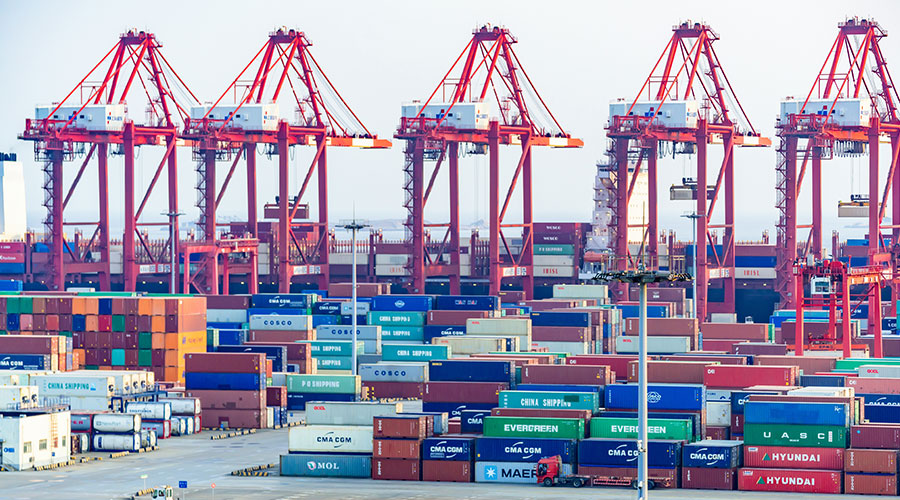


As 2025 approaches, shippers will continue to drive up trans-Pacific container rates, and further increases are likely in the future.
While early entry by importers to avoid President-elect Donald Trump's threatened tariffs on Chinese products helped U.S. imports hit a record high in November, prices are not expected to fall sharply due to a host of looming factors in the coming weeks.
Freight rates for containers shipped from Asia to U.S. West Coast ports rose 8 percent to $4,825 per 40-foot TEU, according to the Baltic Index published by Freightos analysts for the week ended Dec. 27. Prices from Asia to the U.S. East Coast rose 3% to $6,116 per 40-foot TEU.
Judah Levine, head of research at Freightos, said in his weekly update: "Ocean freight rates outside Asia ended the year on a modest upward trend overall, but with the approach of the Lunar New Year and the Trans-Pacific January Consolidated Rate Increase (GRI) announced by ocean carriers, container prices on these routes are likely to come under upward pressure in early 2025." "The seasonal drop in demand from late February should lead to lower rates on routes outside Asia, although the Red Sea diversion will keep rates well above the long-term average, as they will be through 2024."
Ship operators are rerouted as they try to avoid attacks by Houthi militants in Yemen on merchant ships in the Red Sea. The seagoing routes that once used the Suez Canal to connect Asian ports to destinations in Europe, the Mediterranean and the United States are now being rerouted for longer and more expensive journeys.
Factories in Asia are closed for the Lunar New Year, which starts on Jan. 29 and runs through Feb. 12.
"Demand ahead of the Lunar New Year will be combined with higher than normal cargo volumes in the U.S. for this time of year," Levin said. "And, with many U.S. shippers continuing to advance shipments ahead of expected tariff increases, the drop in volumes after Chinese New Year may also be less pronounced than usual."
This early shipment has been reflected in record November cargo volumes at the ports of Long Beach and Los Angeles.
But Levin said Chinese exports to the United States have been declining since the trade war between China and the United States broke out in 2017, and Mexico has replaced China as the largest exporter to the U.S. market.
"At the same time, Chinese investment and trade in Mexico have also surged. Since Mexico's tariffs are generally lower than those of the United States, the USMCA (United States-Mexico-Canada) trade agreement promotes low-barrier trade between Mexico and the United States, the IMMEX program (Manufacturing, Processing Exports, and Export Services) allows many U.S.-bound imports to enter Mexico duty-free, and many Chinese imports to enter the U.S. market through Mexico."
China has been active in building port facilities and distribution centers in Mexico to help nearshore shipments of goods bound for the United States. But Levin noted that in response to Trump's tariff threat, Mexican President Claudia Sheinbaum signed a bill last week that immediately raises tariffs on clothing from China and other countries to 35 percent.
"The bill would also fundamentally prohibit IMMEX from importing certain categories of textiles and apparel, which poses a challenge to importers who rely on these methods to mitigate the impact of U.S. tariffs, including e-commerce sellers who rely on INMEX's decisions to import through Mexico," Levin said.
He added that starting in January, Mexico will also begin implementing stricter reporting requirements for business-to-consumer e-commerce imports.
On transatlantic routes, the Freightos index showed container rates between Asia and Northern Europe rising 4 percent to $5,155 per FEU. Asia-mediterranean freight fell 4% to $5,471 per FEU.
"Strong volumes compared to last year, combined with reduced capacity driven by the Red Sea, have kept transatlantic container rates in 2024 above the loss-making lows of 2023, and prices have been around $2,500 per FEU since October," Levin said.
Levin said freight rates fell 10 percent in the week ended Dec. 27 in anticipation of a possible strike by the International Longshoremen's Association on East Coast ports in the middle of the month. Carriers are announcing a January disruption surcharge on the route.
"A prolonged strike would cause traffic congestion and disruption, which could put additional upward pressure on East Coast routes in January," Levin concluded.





